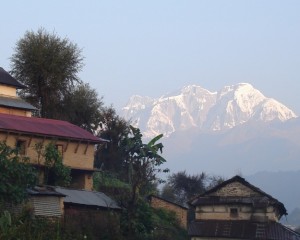Which trek is best Annapurna Base Camp Trek vs Everest Base Camp Trek ?
Nepal is heaven for trekkers and adventurers. But the question comes: which one is best, Annapurna Base Camp vs. Everest Base Camp?
The Annapurna Base Camp Trek (ABC) and the Everest Base Camp Trek (EBC) offer mesmerizing views and exhilarating challenges. At the same time, some argue that the ABC trek is more demanding, with its rugged terrain and unpredictable weather. On the other hand, the EBC trek's higher altitude and longer duration pose more significant obstacles.
The trek is a hard choice. So stay with us to find out which trek is suitable for you.
Annapurna Base Camp Trek (ABC)
The Annapurna Base Camp Trek (ABC) is a popular trekking route in Nepal's Annapurna region. The journey typically begins from Nayapul or Phedi and passes through villages, lush forests, and alpine meadows.

The ABC trek boasts stunning vistas of snow-capped peaks, including Annapurna I (8,091 meters), Machapuchare (6,993 meters), and Hiunchuli (6,441 meters). Trekkers are treated to panoramic views of lush valleys, cascading waterfalls, and rhododendron forests.
Along the trail, trekkers encounter diverse ethnic communities such as Gurungs, Magars, and Thakalis. Villages like Chhomrong and Sinuwa offer opportunities to experience traditional Nepalese hospitality and witness local customs and rituals.
Terrain and elevation gain
The terrain along the ABC trek varies from verdant lowlands to rugged mountain trails. Trekkers ascend gradually and gain elevation as they progress deeper into the Himalayas. The trek's highest point is Annapurna Base Camp, at approximately 4,130 meters (13,549 feet).
Altitude sickness risk
Due to the significant altitude gain, trekkers are susceptible to altitude-related illnesses such as acute mountain sickness (AMS). Adequate acclimatization and gradual ascent are essential to mitigate the risk.
Weather conditions
Weather in the Annapurna region can be unpredictable, ranging from clear skies to heavy snowfall and rain. Trekkers must be ready for changing weather patterns, especially during the monsoon season (June to August).
Accommodation and facilities
Accommodation along the ABC trek varies from teahouses to basic lodges, providing trekkers with a comfortable place to rest and recharge after hiking. Facilities may include simple rooms with shared bathrooms, hot showers (where available), and communal dining areas serving hearty Nepali meals. While amenities are more essential than urban areas, they cater to the needs of trekkers seeking a rustic Himalayan experience.
Everest Base Camp Trek (EBC)
The Everest Base Camp Trek (EBC) is one of the most iconic trekking routes in the world, situated in the Khumbu region of Nepal. The trek starts from Lukla and goes through the Sagarmatha National Park, suspension bridges, and rugged mountain terrain.

The EBC trek offers breathtaking views of the world's highest mountain, Mount Everest (8,848 meters), and other peaks such as Lhotse, Nuptse, and Ama Dablam. Trekkers can witness the sunrise over Everest from Kala Patthar with a truly awe-inspiring experience.
Trekkers can immerse themselves in the rich Sherpa culture along the trail, visiting monasteries, prayer flags, and traditional villages like Namche Bazaar and Tengboche. Sherpa guides and lodge owners extend warm hospitality, sharing their knowledge and customs with trekkers.
Terrain and elevation gain
The terrain along the EBC trek varies from lush forests to rocky moraines and glacial valleys. Trekkers gradually ascend in altitude, facing steep inclines and high mountain passes. The trek's highest point is Kala Patthar at 5,545 meters (18,192 feet)for unparalleled views of Mount Everest and surrounding peaks.
Altitude sickness risk
The EBC trek presents a significant risk of altitude-related illnesses such as acute mountain sickness (AMS) due to the extreme elevation gain. Trekkers must acclimatize adequately, maintaining a slow and steady pace to minimize the risk.
Weather condition
Weather in the Khumbu region can be highly variable, with temperatures ranging from mild to extreme cold and weather patterns changing rapidly. Trekkers may encounter snow, wind, and occasional storms, especially during the winter and monsoon seasons.
Accommodation and facilities
Accommodation along the EBC trek consists of teahouses and lodges, offering basic but comfortable amenities for trekkers. Facilities may include cozy rooms with shared bathrooms, hot showers (where available), and communal dining areas serving hearty meals. While accommodations are rudimentary than in urban areas, they provide trekkers with a cozy retreat amidst the stunning Himalayan landscape.
Which is the best trek for you?
Deciding which trek is best, Annapurna Base Camp (ABC) or Everest Base Camp (EBC), depends on what you're looking for and your abilities.
ABC might be better if you want a challenging but not demanding trek with amazing views and chances to meet locals. There's less risk of feeling sick from the altitude. Plus, you'll see beautiful forests and villages along the way.
But if you dream of seeing the highest mountain in the world up close and are okay with a stricter trek, EBC could be perfect. It's more complex, with steep trails and a higher risk of altitude sickness.
Yet, reaching Everest Base Camp and seeing Mount Everest itself can be incredibly rewarding. You'll also get to experience Sherpa culture and see breathtaking mountain landscapes.
So, whether ABC or EBC is best depends on what kind of adventure you're up for and what you want to see and experience along the way. Both are unique journeys in the Himalayas!

To wrap up, If you pick the Annapurna Base Camp (ABC), or Everest Base Camp (EBC) every trail has its cool stuff and challenges.
The ABC trek is great if you want a bit of a challenge but nothing too crazy. You'll see amazing views and forests, and meet local people.
If you're up for a tougher adventure and want to see Mount Everest up close, go for the EBC trek. It's harder, but reaching Everest Base Camp is super cool. Plus, you'll learn about Sherpa culture along the way.
Nepal Vision Trek is your partner for an epic adventure and many memories to cherish. So, get ready to explore Nepal's Himalayas and have the time of your life!
FAQS







